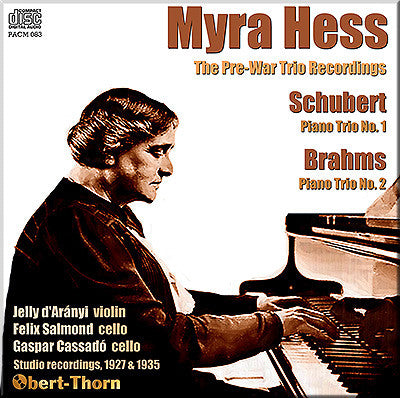
This album is included in the following sets:
This set contains the following albums:
- Producer's Note
- Full Track Listing
- Cover Art
Myra Hess's two excellent pre-war Piano Trio recordings
Schubert and Brahms trios brought together in new Obert-Thorn transfers
The source for the transfer of the Schubert trio (Hess’s recording debut) was a mid-1930s “large label” American Columbia set, while the Brahms came from later pre-war US “microphone label” pressings.
Mark Obert-Thorn
-
SCHUBERT Piano Trio No. 1 in B flat major, D.898
Recorded 28 – 30 December 1927 in New York City
Matrix nos. W 98414-5, 98415-2, 98416-2, 98417-3, 98418-3, 98419-2, 98420-1 and 98421-2
First issued on American Columbia 67436-D through 67439-D in Album 91
-
BRAHMS Piano Trio No. 2 in C major, Op. 87
Recorded 25 October 1935 in EMI Abbey Road Studio No. 3, London
Matrix nos.: CAX 7646-2, 7647-1, 7648-1, 7649-1, 7650-2, 7651-2, 7652-2 and 7653-2
First issued on English Columbia LX 8246 through 8249
Myra Hess piano
Jelly d'Arányi violin
Felix Salmond cello (Schubert)
Gaspar Cassadó cello (Brahms)
Gramophone Historic Review
Brahms - Piano Trio No. 2
This Trio has been overshadowed by its greater neighbour in C minor, not yet, I think, recorded, but has many beauties to recommend it to those who may have passed it by. Tovey says that the " style of the first movement is grandly energetic with deep shadows of mystery, the mystery of nature rather than romance." There is plenty romance, however, in the lovely second subject, most characteristic in shape, which the piano first sings, and in the charming codetta for the strings added to it. In the development section which begins on Part 2 notice the Schumannesque augmentation of the opening tune on the 'cello.
The slow movement is scored with violin and 'cello two octaves apart, except for three bars at the end, an effect which adds to the " heroic pathos" of the music. The tune is the theme of a set of five variations of which the first is overcast with the deep shadows of mystery which Tovey speaks of above, while the fourth variation in the major key is of a rich texture, simultaneously combining two melodies, one for the piano, the other for the strings, but both growing from the same stem.
I cannot better Sir Donald Tovey's description of the next movement—" the dark pianissimo scherzo with its huge white cloud-bank trio." It is a grand storm piece of symphonic size, but never straining the limits of its medium.
I am not sure that the players realise the"
humour and mystery" of the last movement, though they certainly do not
take it too fast. It is the one movement in the work which smells
somewhat of the lamp and deserves, in part, Tchaikovsky's criticism of
all Brahms's music- " it is all very serious, very distinguished,
apparently even original : but in spite of all this the chief thing is
lacking-beauty.''
To the true Brahmsians, amongst whom I number
myself, the verdict is incomprehensible except in regard to a few
isolated movements or passages : and the same could be said of any great
composer. The ensemble lacks many of those qualities which gave such
lustre to the Schubert Trio in E flat reviewed in this number. Cassado's
tone, always beautiful, is consistently too heavy arid overweighs the
violinist, especially when they are playing an octave or two octaves
apart, and Jelly d'Aranyi is curiously disappointing. Her tone is thin
and sometimes shrill—whith is certainly not the case in the concert
hall. Myra Hess, who plays splendidly all through, sounds too distant.
The important question of balance is therefore not solved
satisfactorily. The musicianship of these three artists is, of course,
never in question, so that there are many lovely moments and a fine
breadth in the interpretation which cannot be seriously damaged by the
criticisms set out above. The recording is admirable.
A.R. - The Gramophone, June 1936 (review of original 78rpm issue of the Brahms)

